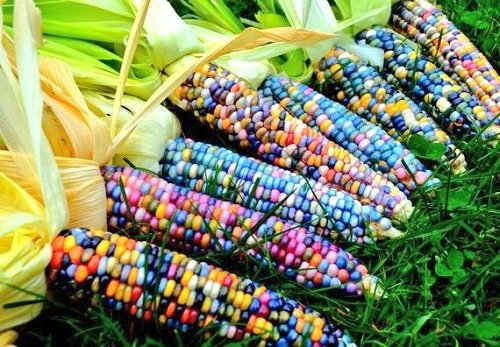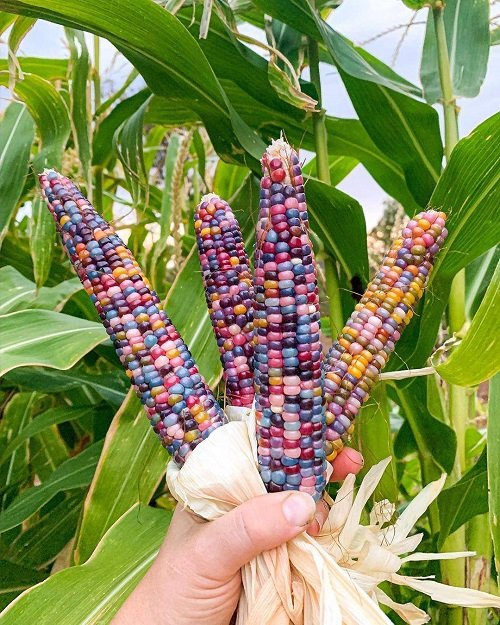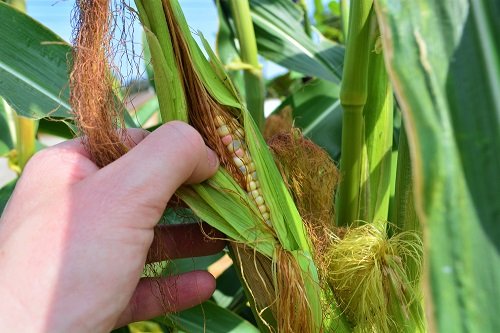Learn How to Grow Glass Gem Corn – from planting to harvesting, discover everything about this stunning heirloom variety!

Glass gem corn is a stunning heirloom variety that can be grown for both ornamental and practical purposes. These tiny gemstone-like corns are not only edible, but you can also use them in crafts, and if you have kids, this is the perfect crop to involve them in gardening.
Learn Planting and Growing Corn in Containers here
What is Glass Gem Corn?
Glass gem corn is known for its vibrant rainbow hues. This type of corn, also known as “flint corn,” is typically not eaten fresh but instead used for making popcorn or ground into corn flour.
In order to harvest flint corn, the corn is left on the plant until the kernels have fully dried and lost their shine and color and have hardened to the texture of flint. It is only at this point that the corn is ready for harvest, hence the name “flint corn.”
In addition to its practical uses, Glass Gem corn also has ornamental value. The corn variety gained widespread attention in 2012 after pictures were shared online, making it an internet sensation. Since then, more and more people have become interested in growing this stunningly colorful corn for themselves.
A Colorful History of Glass Gem Corn
These famous gemstone-like corns appeared again due to the effort of a man named Carl Barnes, an Oklahoma farmer of Cherokee descent. Carl was passionate about preserving his Native American heritage, and he embarked on a mission to rediscover and conserve ancient corn varieties. Little did he know that his dedication would lead to the creation of a true masterpiece.
In the early 1990s, Carl began crossing various heirloom corn varieties to create something unique and visually striking. His efforts soon paid off as the vibrant Glass Gem corn was born. This exquisite variety displays a dazzling array of colors, with each kernel resembling a tiny, iridescent gemstone.
As Carl aged, he sought the help of a fellow seedsman, Greg Schoen, to continue his legacy. Greg eagerly took on the challenge and began sharing Glass Gem seeds with others, including Bill McDorman, the owner of a small seed company. Bill recognized the potential of this mesmerizing corn and added it to his catalog, making it available to gardeners across the United States.
Once people started growing Glass Gem corn in their gardens, it quickly gained popularity on social media. Images of the breathtaking corn went viral, and the demand for seeds skyrocketed. Today, Glass Gem corn is cherished by gardeners and corn enthusiasts alike for its unique beauty and rich history.
Not only is Glass Gem corn visually stunning, but it’s also versatile in the kitchen. While it’s not ideal for eating fresh off the cob, it can be ground into cornmeal, popped like popcorn, or used decoratively in crafts.
So, if you haven’t planted it yet, why not give Glass Gem corn a try this year? It’s a fantastic way to add a touch of history, color, and excitement to your gardening experience!
Propagating Glass Gem Corn

It is advisable to start sowing corn early indoors and transplant the seedlings outdoors when they are young. To avoid disturbing the roots, biodegradable plant pots or toilet roll tubes can be used as modules.
- It is important not to sow or transplant too early. Wait until all risks of frost and nighttime chill have passed and the soil has warmed up to at least 55-60 degrees Fahrenheit before sowing or planting the crops in your garden.
- For optimal pollination and yield, plant corn in blocks of at least three rows instead of a single long row. This is because corn is wind-pollinated, and planting in blocks increases pollination rates.
- Plant the corn with a spacing of around 5-6 inches between each plant within the block. Rest all germination process is similar to other corn varieties.
Requirements for Growing Glass Gem Corn

Location
For optimal growth, Glass Gem Corns require abundant sunlight and warmth during the summer season. It is recommended to plant it in a location that receives full sun exposure for atleast 7-8 hours every day and is sheltered from strong winds.
While this corn can tolerate partial shade, it won’t produce as much yield.
Soil
For optimal growth, it is crucial to plant Glass Gem Corn in rich, fertile soil. It grows best in slightly acidic to neutral soil with a pH range of 5.8 to 7.0. It will be a good idea to add plenty of organic matter, too, like leaf mold, compost, or manure in the growing medium at the time of planting.
Water
Watering requirements for glass gem corn depend on the climate. Generally, it should be watered thoroughly in a way that the growing medium remains evenly moist, as long as the soil does not dry out completely, it will do just fine.
During the hot summer months, it may need to be watered more often. Make sure the soil is damp but not soggy.
Glass Gem Corn Care

Fertilizer
It is best to use a balanced fertilizer with an equal ratio of nitrogen, phosphorus, and potassium. A 5-10-10 fertilizer is ideal, as it will provide the necessary nutrients.
The application should occur two to three times during the growing season, once at planting, once at tasselling, and once again at the beginning of the milk stage.
Be sure to follow the instructions on the fertilizer label for proper application.
Mulching
Mulching helps the soil retain moisture and improves its fertility. It also keeps weeds away and moderates soil temperatures.
Choose a mulch that is organic and light-colored, such as straw, wood chips, or shredded leaves.
Avoid mulches that are dark-colored, such as black plastic or tarps, as they can absorb too much heat.
Another important part of mulching your gem corn is to ensure the mulch does not come in contact with the stems or leaves of the corn plants. If it does, it can cause the plants to rot. Gently pull the mulch away from the plants as they grow.
Finally, water your gem corn regularly to keep the soil moist. This will help the mulch retain moisture and also encourage the plants to grow healthy and strong.
Pests and Diseases
Pests: Corn earworm, European corn borer, corn leaf aphid, western corn rootworm
Diseases: Gray Leaf Spot, Northern Corn Leaf Blight, Stewart’s Wilt, Anthracnose, Corn Smut, Southern Corn Leaf Blight, Common Rust, Fusarium Ear Rot, and Diplodia Ear Rot.
- Remove and discard any diseased plants or parts of the plant to prevent the spread of the disease or pest.
- Use insecticidal soap or horticultural oil to control sucking pests such as aphids.
- Utilize natural pest control methods such as using beneficial insects like ladybugs, praying mantis, and lacewings to control pests.
Harvesting Glass Gem Corn
The best time to harvest glass gem corn is when the kernels have reached full maturity, typically in late summer or early fall. The ears should be left on the stalk until the husks have dried and turned brown, and the kernels should feel firm when squeezed.
Once harvested, the corn should be husked as soon as possible to prevent mold and spoilage. The kernels can then be dried, removed, and stored for future use. Glass gem corn can be used just like any other type of corn and is great for making popcorn, cornmeal, and other dishes.
You can also save the seeds for next year’s planting: Pick the most colorful seeds for vibrant glass gem corns, examine the dried seeds, and choose those with the brightest and most diverse hues. Store them in a cool, dry place, ideally in airtight containers.
By hand-picking seeds with the most striking colors and patterns, you can enhance the color variation in your future harvests, resulting in even more eye-catching corn cobs.
Glass Gem Corn Uses

Glass gem corn can be used for making cornmeal, popcorn, and flour. The kernels can be grounded and used as a colorful and flavorful addition to pancakes, muffins, and other baked goods.
It can also be used to make jewelry and decorations, as well as for fall decorations.

